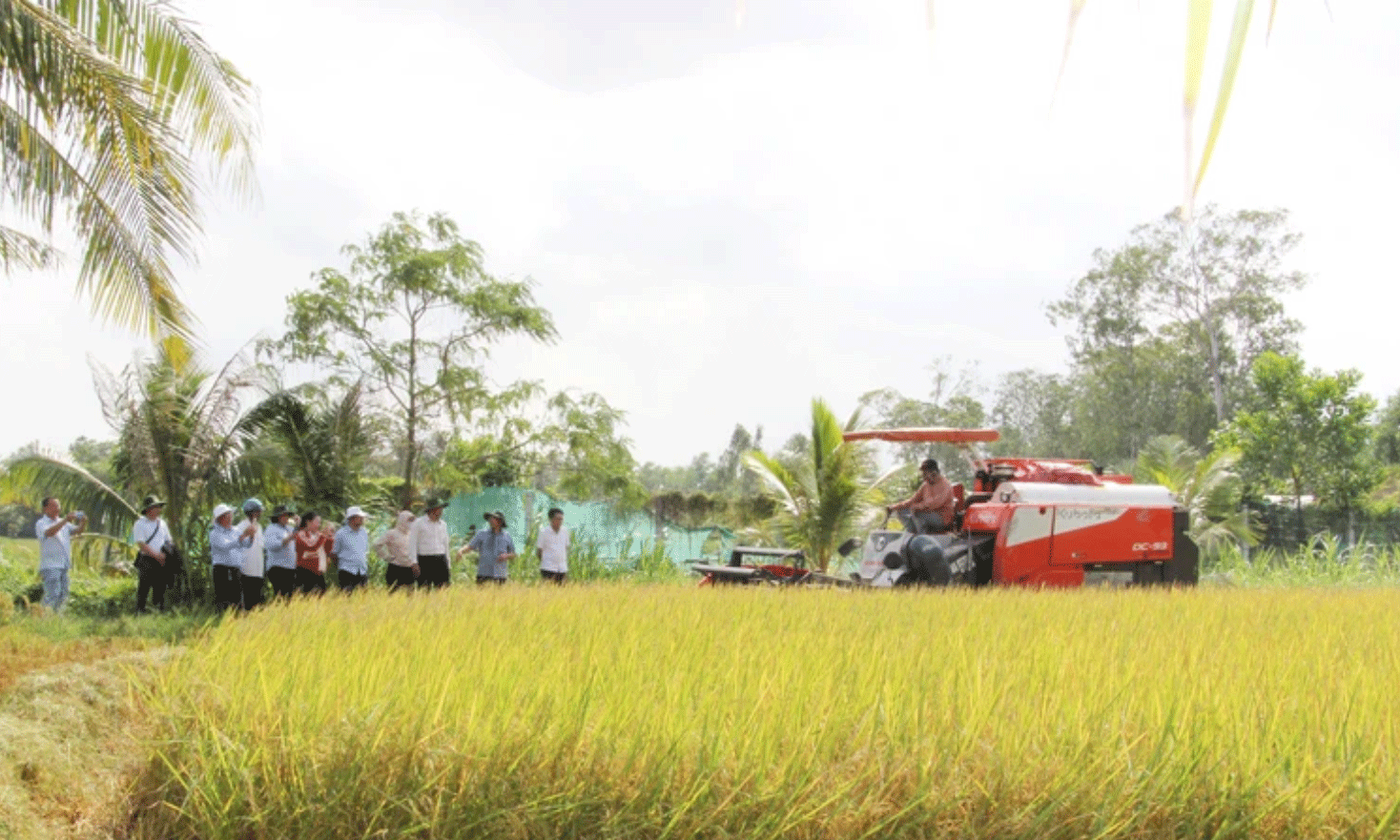 |
| Pilot model of low-emission rice cultivation at Phuoc Hao Agricultural Cooperative, Tra Vinh province. |
According to the National Agricultural Extension Center, the Mekong Delta is a key rice production area, ensuring food security and contributing greatly to rice exports in recent years.
However, this area is also affected by rising sea levels, saltwater intrusion, drought, increasingly complex natural disasters, and declining soil quality. Currently, the traditional rice production model has many limitations, so there needs to be a strong transformation in both farming techniques and production organization.
In order to solve the problem of sustainable development, increase the value of rice production and reduce greenhouse gas emissions, on November 27, 2023, the Government issued Decision No. 1490/QD-TTg approving the Project "Sustainable development of one million hectares of high-quality and low-emission rice cultivation associated with green growth in the Mekong Delta by 2030" (hereinafter referred to as the Project).
This is considered a breakthrough in restructuring the rice industry, helping to improve economic efficiency, adapt to climate change, and promote green growth.
Head of the Department of Crop and Forestry Extension (National Agricultural Extension Center) Hoang Tuyen Phuong said: “After one year of implementation, the Project has initially shown positive results from pilot models in localities. Many households have proactively applied technical advances such as: reducing the amount of seeds sown, applying alternating wet and dry irrigation, using balanced fertilizers, mechanizing production and straw management and applying digital technology... These changes not only help reduce input costs, increase profits, but also contribute to significantly reducing greenhouse gas emissions and improving rice quality”.
| Through evaluation, the models help reduce production costs from 8.2% to 24.2% by reducing 30 to 50% of seeds, saving 30 to 70kg of fertilizer/ha, reducing 1 to 4 times of spraying pesticides and reducing 30 to 40% of irrigation water, at the same time, productivity increases by 2.4 to 7%, profits increase from 4 to 7.6 million VND/ha compared to traditional farming. |
During the implementation process, community extension forces, cooperatives and cooperative groups are important links, playing the role of a bridge between implementing policies and practical activities in the fields. They not only help to transfer knowledge and techniques to farmers but also participate in reorganizing production, building linkages, coordinating value chains and promoting the application of technology in agricultural production.
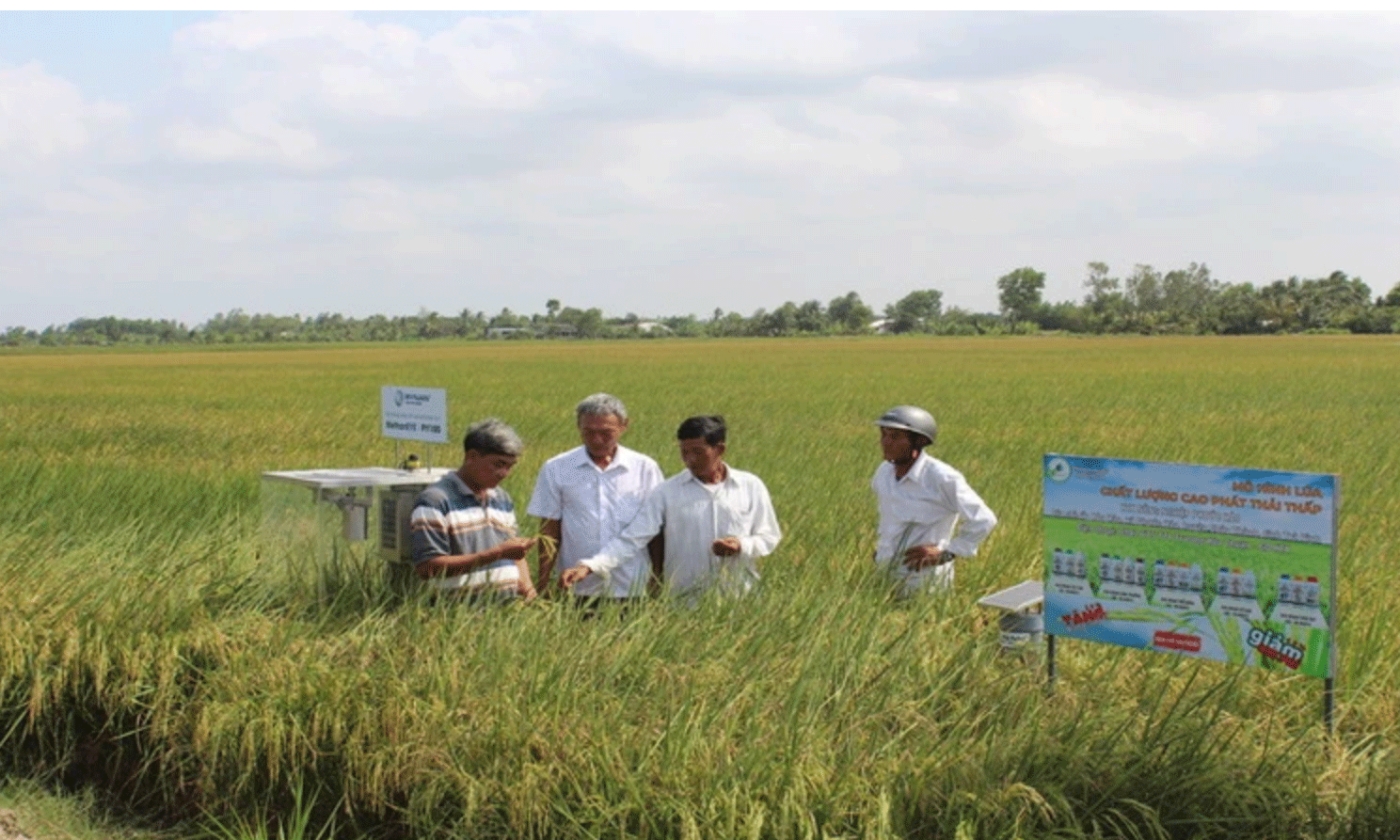 |
| Farmers check rice in the pilot model of 1 million hectares of high-quality rice in Tra Vinh province. |
To date, the Mekong Delta region has implemented seven central-level pilot models in five localities: Kien Giang, Soc Trang, Tra Vinh, Dong Thap and Can Tho. Initial results show that the high-quality rice cultivation model, reducing emissions, brings clear benefits both economically and environmentally.
In Tra Vinh province, there are two models implemented at Phuoc Hao Agricultural Cooperative and Phat Tai Agricultural Cooperative, with an area of 98.4 hectares and 94 participating households.
Through evaluation, the models help reduce production costs from 8.2% to 24.2% by reducing the amount of seeds by 30 to 50%, saving 30 to 70kg of fertilizer/ha, reducing 1 to 4 times of spraying pesticides and reducing the amount of irrigation water by 30 to 40%. At the same time, productivity increases by 2.4 to 7%, profits increase by 4 to 7.6 million VND/ha compared to traditional farming.
More importantly, the model has contributed to reducing greenhouse gas emissions by an average of 2 to 12 tons of CO₂/ha. Notably, all harvested rice is committed to be purchased by businesses at a price 200 to 300 VND/kg higher than paddy, creating motivation for farmers to participate.
A representative of the Department of Agriculture and Environment of Tra Vinh province said that in the province, there are two models implemented at Phuoc Hao Agricultural Cooperative and Phat Tai Agricultural Cooperative, covering an area of 98.4 hectares with 94 participating households. After one year of implementation, the two models have recorded many positive signals, helping to reduce costs, increase productivity, quality and profits for farmers. On the other hand, farmers have boldly applied new farming methods, promoting production according to the value chain.
Promoting the results achieved after the 2024 summer-autumn crop in two pilot models, Tra Vinh province will expand the model with six cooperatives participating in the 2024 autumn-winter crop with an area of 208.4 hectares; by the 2024-2025 winter-spring crop, 16 cooperatives have participated with an area of 883.72 hectares.
The pilot model was implemented at Phuoc Hao Agricultural Cooperative, Phuoc Hao Commune, Chau Thanh District (Tra Vinh) with an area of 50 hectares with 46 participating households. The rice variety used was ST24, a high-quality rice variety.
According to the representative of the Cooperative, after three seasons of pilot rice cultivation, many positive results have been achieved, of which the winter-spring crop of 2024-2025 is the crop with better results than previous crops.
According to statistics, in this crop, the amount of seeds used was only 60 to 70 kg/ha, the rice yield reached 7.5 tons/ha, an increase of 5 to 10% compared to production outside the model; with a revenue of 72 million VND/ha, the profit from the model in the winter-spring crop reached 48.5 million VND/ha, 15 to 25% higher. In particular, the pilot model also reduced emissions by 20 to 30% compared to production outside the model.
The National Agricultural Extension Center believes that, despite initial positive results, the implementation of the Project still faces many difficulties and challenges. Many localities still do not fully understand the core content and implementation methods. Furthermore, some localities focus too much on creating and selling carbon credits instead of focusing on implementing sustainable farming processes and reducing production costs for people.
In addition, irrigation infrastructure is a fundamental and key factor to implement emission reduction farming measures, but investment capital is not suitable for the implementation roadmap; some localities and people are mainly interested in irrigation measures, not paying due attention to straw treatment.
Burning straw after harvest is still common, causing environmental pollution and wasting resources that could be reused for agricultural production. Currently, the rate of rice production linkage in the Mekong Delta is only under 30%, not strong enough to ensure the stability and long-term development of the Project…
"In the coming time, it is necessary to continue training to improve the capacity of community agricultural extension teams, cooperatives and cooperative groups; increase support for community agricultural extension teams, cooperatives and cooperative groups to build and strengthen sustainable value chain linkages". DEPUTY DIRECTOR OF NATIONAL AGRICULTURAL EXTENSION CENTER HOANG VAN HONG |
For the Project to be effective, in the coming time, ministries, branches and localities need to further promote training and guidance for farmers to access sustainable farming methods; create conditions for cooperatives and businesses to participate in the high-quality rice production chain, reducing emissions.
On the other hand, it is necessary to plan stable and long-term raw material areas to develop high-quality, low-emission rice, build growing area codes in areas participating in the Project; Focus on investing in and synchronously upgrading production infrastructure in areas participating in the Project, especially irrigation infrastructure to meet the requirements of proactive irrigation, support transportation and mechanization.
Promote research and transfer of new technical advances to people for effective application in production; support the building of low-carbon rice brands and trademarks.
According to Deputy Director of the National Agricultural Extension Center Hoang Van Hong: “In the coming time, it is necessary to continue training to improve the capacity of community agricultural extension teams, cooperatives and cooperative groups. On that basis, training courses need to specialize in technical processes of emission reduction cultivation, such as: row sowing, drone sowing, alternating flood and dry irrigation and applying sustainable rice cultivation models that need to be continuously implemented. Along with that, it is necessary to increase support for community agricultural extension teams, cooperatives and cooperative groups to build and strengthen sustainable value chain linkages. At the same time, training in value chain management skills and market connections is also very important to ensure stable consumption of agricultural products, thereby increasing farmers' income".
( According to nhandan.vn )
Source: https://baoapbac.vn/kinh-te/202505/phat-trien-ben-vung-mot-trieu-hecta-chuyen-canh-lua-chat-luong-cao-1042338/




![[Photo] Prime Minister Pham Minh Chinh starts construction of vital highway through Thai Binh and Nam Dinh](https://vphoto.vietnam.vn/thumb/1200x675/vietnam/resource/IMAGE/2025/5/12/52d98584ccea4c8dbf7c7f7484433af5)
![[Photo] Prime Minister Pham Minh Chinh works with the Standing Committee of Thai Binh Provincial Party Committee](https://vphoto.vietnam.vn/thumb/1200x675/vietnam/resource/IMAGE/2025/5/12/f514ab990c544e05a446f77bba59c7d1)
![[Photo] Prime Minister Pham Minh Chinh receives Swedish Minister of International Development Cooperation and Foreign Trade](https://vphoto.vietnam.vn/thumb/1200x675/vietnam/resource/IMAGE/2025/5/12/ae50d0bb57584fd1bbe1cd77d9ad6d97)




























































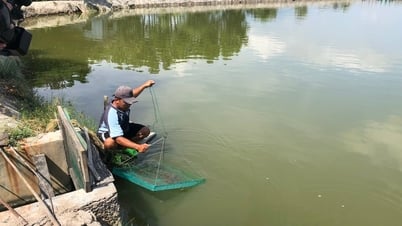

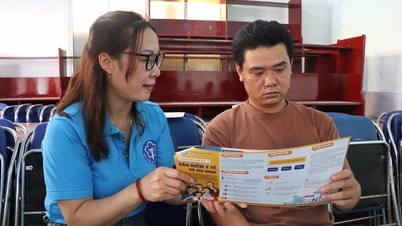
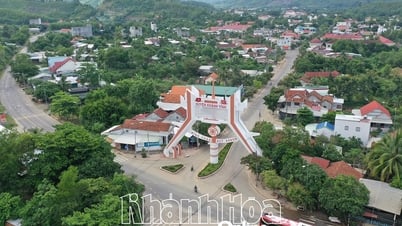











Comment (0)